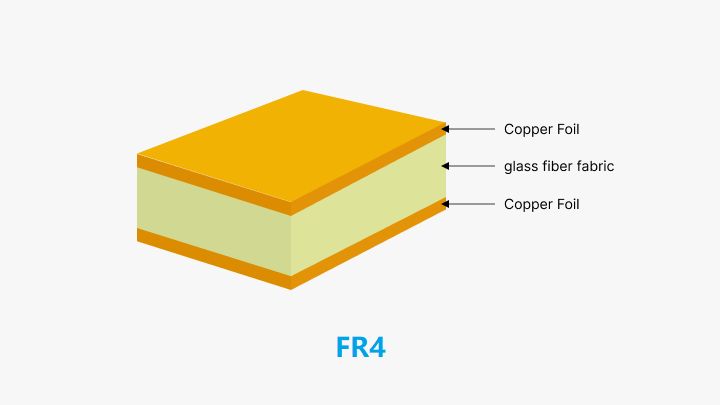FR-4 Material for Your PCB: When to Use and When to Avoid It
FR-4 is a cost-effective, versatile PCB material, ideal for consumer electronics and prototyping but unsuitable for high-frequency or temperature needs. Consider thickness, flexibility, and impedance.
Printed circuit boards represent the backbone of modern electronic devices. They rely greatly on the proper substrate material to function correctly. FR-4 is a class of fiberglass reinforced epoxy laminate that is among the most popular materials. The main reasons for its popularity are desirable properties and cost-effectiveness. FR-4 material may be more or less suitable depending on the needs of your project. To this effect, in this article, we will review when to use FR-4 for your PCB and when other materials can offer the best solutions for your needs. We will also give tips on how to choose the right FR-4 material with consideration to several factors in terms of thickness, weight, space, flexibility, and impedance.
When to Use FR-4 Material
Typical Electronic Equipment
FR-4 finds extensive use in consumer electronics due to its economic friendliness and reliable performance. It can be used in devices that do not need high-frequency applications or high-temperature performance, like television systems, game consoles, and other household electronics.
General Industrial Applications
FR-4 is good enough for applications that require good electrical insulation with mechanical strength, like industrial control systems.
Prototyping and Testing
FR-4 is inexpensive and easy to work with; therefore, ideally suited for early stages of product prototyping and testing, where cost is a factor in a product's development.
Low to Medium-Frequency Applications
FR-4 works well at low to medium frequencies. FR-4 substrate material can be used for digital and analog circuitry that does not require high frequency.

Multilayer PCB Construction
FR-4 provides one of the most common materials for multilayer boards because of its structural integrity, providing consistent layer bonding and stability in dimensions.
When Not to Use FR-4 Material
High Frequency Signals
FR-4 has a high dielectric constant and a relatively high dissipation factor. These characteristics contribute to the loss of a signal at high frequencies; typically 0.020 (tan(δ)) at 1GHz. In high-speed/high-frequency circuits, one needs to use materials that are superior in dielectric performance, including those by Rogers and high-frequency laminates.
High Operating Temperature Requirements
The standard FR-4 has low thermal conductivity, and a glass transition temperature between 130°C to 140°C that limits its application at high temperatures. For applications requiring excellent thermal resistance-power electronics or automotive under-hood applications-metal-core or high Tg FR-4 materials are preferred.
Lead-Free Soldering
Lead-free soldering requires higher processing temperatures. The standard FR-4 perhaps may not support such high temperatures, and high Tg FR-4 materials should be used to satisfy the lead-free process requirements.
Flexibility Requirements
In applications where flexibility or dynamic bend is required, the rigidity of FR-4 becomes a drawback. In such cases, flexible or rigid-flex PCBs manufactured with polyimide or other suitable material will be more adequate.
How to Choose the Correct FR-4 Material
When it comes to FR-4, using it is not a problem but the type and specification to use. Following are some key items to keep in mind:
Thickness
Thickness for FR4 PCBs ranges from 0.127 mm to 3.175 mm. Depending on the thickness of choice, functional aspects of the board could be compromised.
Connections: Make sure the chosen connectors support that thickness as it may be that the connector puts the limit on the thickness that you can use. For redesign projects, match the specifications of the existing system.
Available Space: Small devices, like those that use Bluetooth modules, may require thinner PCBs so that they could fit in the given space. Smaller in size and lighter in weight, these are the essential features for portable electronic equipment.
Flexibility Options
Thinner FR-4 sheets offer more flexibility, which is an advantage or disadvantage depending on the application. The surroundings and working conditions of the device must be kept in consideration when using these boards, since, if not handled properly, these may bend or warp during soldering.
Controlled Impedance
High-frequency designs require controlled impedance that relies on a stable dielectric constant. A balanced thickness can thereby help achieve this characteristic.
Component Compatibility
Component types, especially through-hole components, may behave better with certain board thicknesses, therefore affecting manufacturability and reliability.
Design and Weight Consideration
The thin boards are lighter and hence easily integrated into space-constrained devices; very thin or too thick boards will create mechanical issues of warping or excess weight.
Conclusion
FR-4 represents an excellent performance-to-cost ratio for most PCB applications. However, FR-4's utility is bounded by design and environmental constraints. Truly understanding the technical demands of a project will provide key insight into when FR-4 is an appropriate fit and when alternative material options should be explored. At PCBX, we offer a range of options for materials, all designed to support you in making the right decisions, so your projects meet both functional and financial objectives. For prototyping, high-volume production, or specialty applications, knowing when and how to use FR-4 can greatly impact the success and longevity of an electronic design.
Hot Tags:
Contact us

If you can't find what you're looking for, please contact us.
Article

FR4 is a key PCB substrate with excellent electrical insulation, mechanical strength, and thermal resistance. It's valued for its balance of cost and performance, crucial for a wide range of applications.

FR4 is a favored PCB material for its cost-effectiveness and versatility. However, its thickness tolerance impacts mechanical strength, thermal performance, and electrical efficiency, affecting overall PCB reliability and performance.

PCBs (Printed Circuit Boards) are fundamental in electronics, composed of multiple layers like silkscreen, soldermask, copper, and substrate, chosen for specific electrical functions.

